Network Protocols, SDLC & ITSM: Assessment Solution - University
VerifiedAdded on 2022/11/14
|14
|3637
|342
Homework Assignment
AI Summary
This assignment solution delves into various aspects of network protocols, SDLC, and ITSM. It begins with calculations of protocol overhead for both IPv4 and IPv6, analyzing the coexistence of TCP and IP within the same protocol stack. The solution then explores the Agile method, highlighting its advantages and disadvantages, and compares it with the Evolutionary software development process. The analysis extends to the uniqueness of the Apple design process, examining its distinct features. Finally, the assignment addresses three common reasons for project failure. The document offers a comprehensive overview of these topics, providing detailed explanations and insights into each area.

Running head: Network Protocols, SDLC & ITSM
Network Protocols, SDLC & ITSM
Name of the Student
Name of the University
Author Note
Network Protocols, SDLC & ITSM
Name of the Student
Name of the University
Author Note
Paraphrase This Document
Need a fresh take? Get an instant paraphrase of this document with our AI Paraphraser
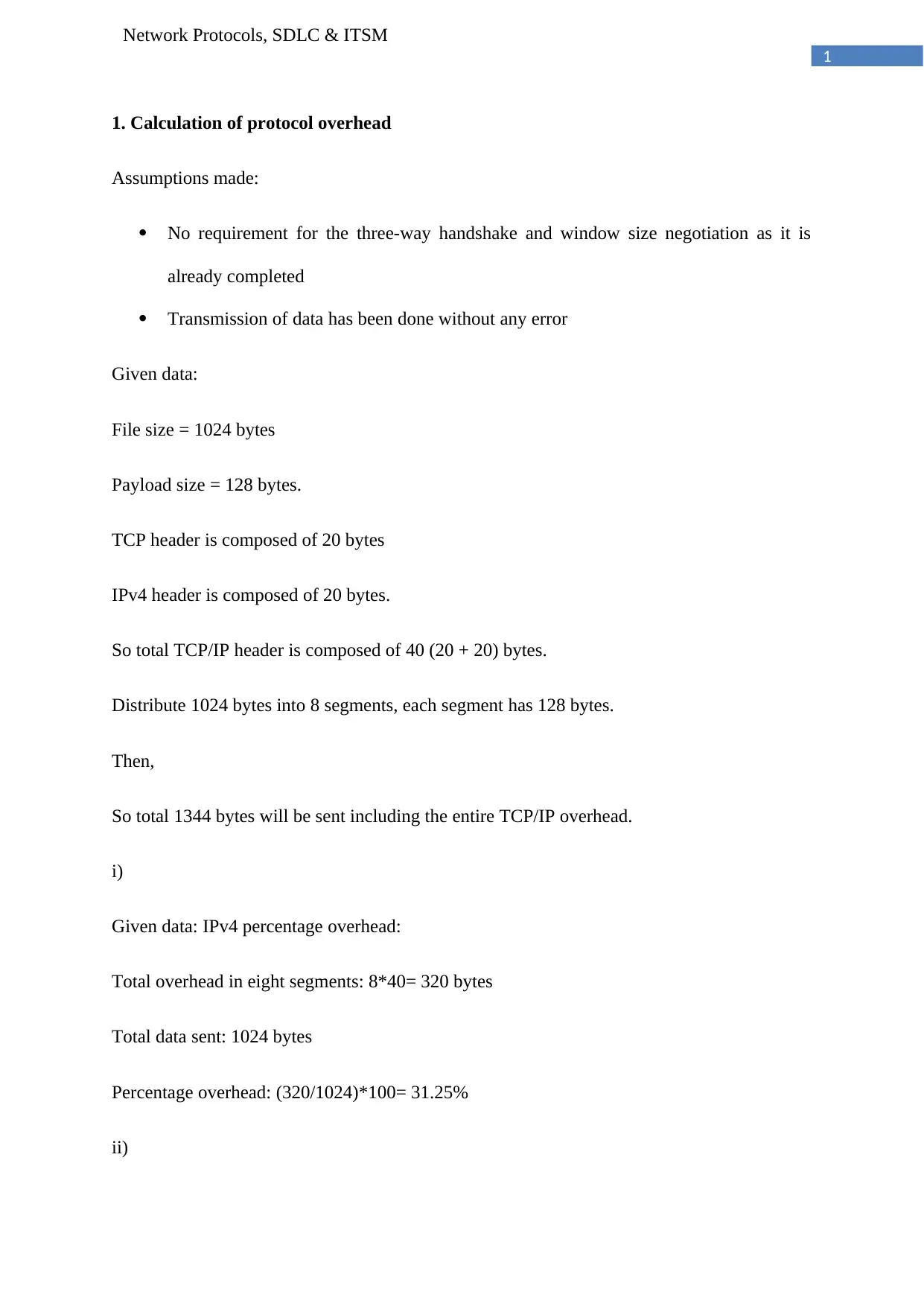
1
Network Protocols, SDLC & ITSM
1. Calculation of protocol overhead
Assumptions made:
No requirement for the three-way handshake and window size negotiation as it is
already completed
Transmission of data has been done without any error
Given data:
File size = 1024 bytes
Payload size = 128 bytes.
TCP header is composed of 20 bytes
IPv4 header is composed of 20 bytes.
So total TCP/IP header is composed of 40 (20 + 20) bytes.
Distribute 1024 bytes into 8 segments, each segment has 128 bytes.
Then,
So total 1344 bytes will be sent including the entire TCP/IP overhead.
i)
Given data: IPv4 percentage overhead:
Total overhead in eight segments: 8*40= 320 bytes
Total data sent: 1024 bytes
Percentage overhead: (320/1024)*100= 31.25%
ii)
Network Protocols, SDLC & ITSM
1. Calculation of protocol overhead
Assumptions made:
No requirement for the three-way handshake and window size negotiation as it is
already completed
Transmission of data has been done without any error
Given data:
File size = 1024 bytes
Payload size = 128 bytes.
TCP header is composed of 20 bytes
IPv4 header is composed of 20 bytes.
So total TCP/IP header is composed of 40 (20 + 20) bytes.
Distribute 1024 bytes into 8 segments, each segment has 128 bytes.
Then,
So total 1344 bytes will be sent including the entire TCP/IP overhead.
i)
Given data: IPv4 percentage overhead:
Total overhead in eight segments: 8*40= 320 bytes
Total data sent: 1024 bytes
Percentage overhead: (320/1024)*100= 31.25%
ii)
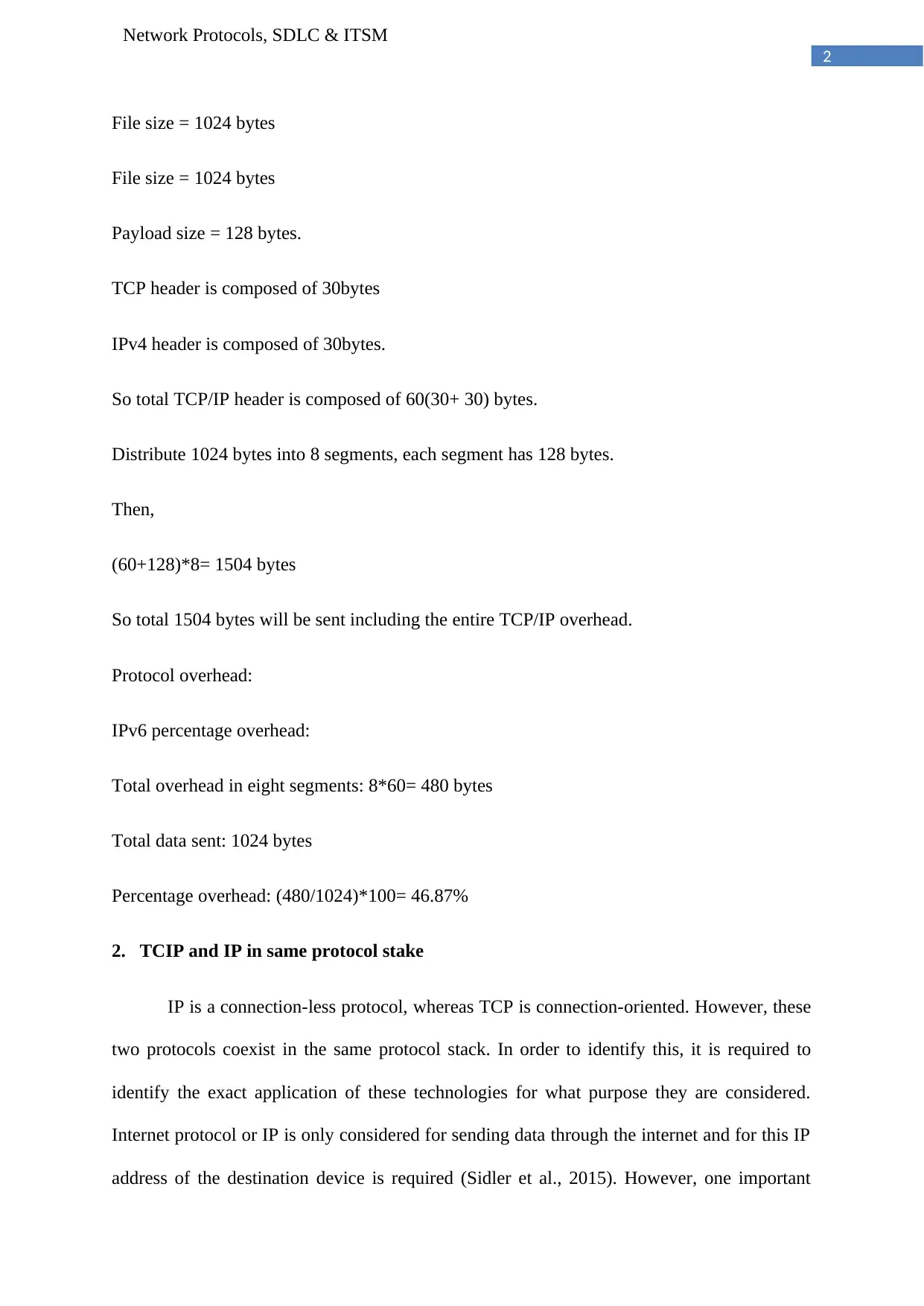
2
Network Protocols, SDLC & ITSM
File size = 1024 bytes
File size = 1024 bytes
Payload size = 128 bytes.
TCP header is composed of 30bytes
IPv4 header is composed of 30bytes.
So total TCP/IP header is composed of 60(30+ 30) bytes.
Distribute 1024 bytes into 8 segments, each segment has 128 bytes.
Then,
(60+128)*8= 1504 bytes
So total 1504 bytes will be sent including the entire TCP/IP overhead.
Protocol overhead:
IPv6 percentage overhead:
Total overhead in eight segments: 8*60= 480 bytes
Total data sent: 1024 bytes
Percentage overhead: (480/1024)*100= 46.87%
2. TCIP and IP in same protocol stake
IP is a connection-less protocol, whereas TCP is connection-oriented. However, these
two protocols coexist in the same protocol stack. In order to identify this, it is required to
identify the exact application of these technologies for what purpose they are considered.
Internet protocol or IP is only considered for sending data through the internet and for this IP
address of the destination device is required (Sidler et al., 2015). However, one important
Network Protocols, SDLC & ITSM
File size = 1024 bytes
File size = 1024 bytes
Payload size = 128 bytes.
TCP header is composed of 30bytes
IPv4 header is composed of 30bytes.
So total TCP/IP header is composed of 60(30+ 30) bytes.
Distribute 1024 bytes into 8 segments, each segment has 128 bytes.
Then,
(60+128)*8= 1504 bytes
So total 1504 bytes will be sent including the entire TCP/IP overhead.
Protocol overhead:
IPv6 percentage overhead:
Total overhead in eight segments: 8*60= 480 bytes
Total data sent: 1024 bytes
Percentage overhead: (480/1024)*100= 46.87%
2. TCIP and IP in same protocol stake
IP is a connection-less protocol, whereas TCP is connection-oriented. However, these
two protocols coexist in the same protocol stack. In order to identify this, it is required to
identify the exact application of these technologies for what purpose they are considered.
Internet protocol or IP is only considered for sending data through the internet and for this IP
address of the destination device is required (Sidler et al., 2015). However, one important
⊘ This is a preview!⊘
Do you want full access?
Subscribe today to unlock all pages.

Trusted by 1+ million students worldwide
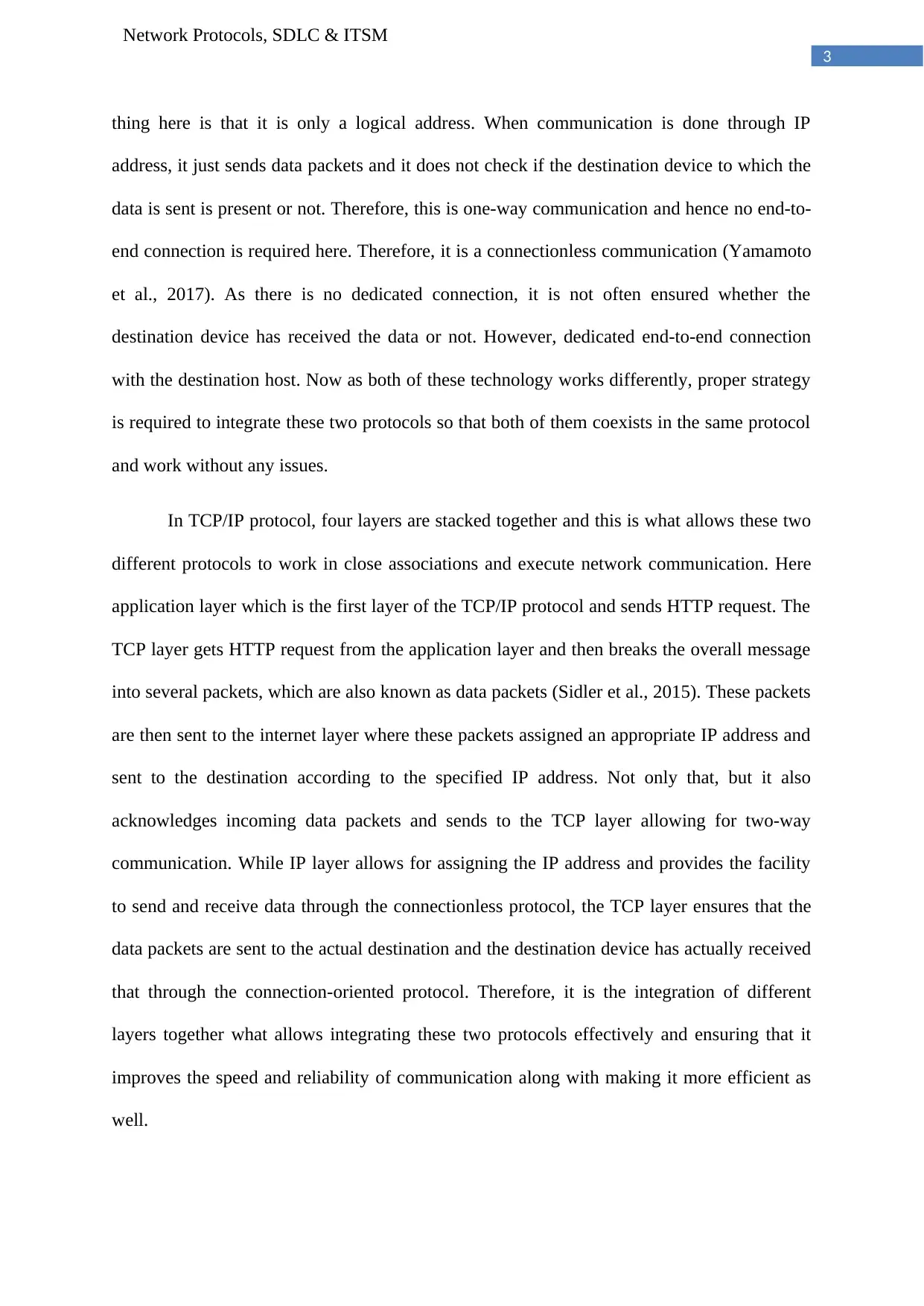
3
Network Protocols, SDLC & ITSM
thing here is that it is only a logical address. When communication is done through IP
address, it just sends data packets and it does not check if the destination device to which the
data is sent is present or not. Therefore, this is one-way communication and hence no end-to-
end connection is required here. Therefore, it is a connectionless communication (Yamamoto
et al., 2017). As there is no dedicated connection, it is not often ensured whether the
destination device has received the data or not. However, dedicated end-to-end connection
with the destination host. Now as both of these technology works differently, proper strategy
is required to integrate these two protocols so that both of them coexists in the same protocol
and work without any issues.
In TCP/IP protocol, four layers are stacked together and this is what allows these two
different protocols to work in close associations and execute network communication. Here
application layer which is the first layer of the TCP/IP protocol and sends HTTP request. The
TCP layer gets HTTP request from the application layer and then breaks the overall message
into several packets, which are also known as data packets (Sidler et al., 2015). These packets
are then sent to the internet layer where these packets assigned an appropriate IP address and
sent to the destination according to the specified IP address. Not only that, but it also
acknowledges incoming data packets and sends to the TCP layer allowing for two-way
communication. While IP layer allows for assigning the IP address and provides the facility
to send and receive data through the connectionless protocol, the TCP layer ensures that the
data packets are sent to the actual destination and the destination device has actually received
that through the connection-oriented protocol. Therefore, it is the integration of different
layers together what allows integrating these two protocols effectively and ensuring that it
improves the speed and reliability of communication along with making it more efficient as
well.
Network Protocols, SDLC & ITSM
thing here is that it is only a logical address. When communication is done through IP
address, it just sends data packets and it does not check if the destination device to which the
data is sent is present or not. Therefore, this is one-way communication and hence no end-to-
end connection is required here. Therefore, it is a connectionless communication (Yamamoto
et al., 2017). As there is no dedicated connection, it is not often ensured whether the
destination device has received the data or not. However, dedicated end-to-end connection
with the destination host. Now as both of these technology works differently, proper strategy
is required to integrate these two protocols so that both of them coexists in the same protocol
and work without any issues.
In TCP/IP protocol, four layers are stacked together and this is what allows these two
different protocols to work in close associations and execute network communication. Here
application layer which is the first layer of the TCP/IP protocol and sends HTTP request. The
TCP layer gets HTTP request from the application layer and then breaks the overall message
into several packets, which are also known as data packets (Sidler et al., 2015). These packets
are then sent to the internet layer where these packets assigned an appropriate IP address and
sent to the destination according to the specified IP address. Not only that, but it also
acknowledges incoming data packets and sends to the TCP layer allowing for two-way
communication. While IP layer allows for assigning the IP address and provides the facility
to send and receive data through the connectionless protocol, the TCP layer ensures that the
data packets are sent to the actual destination and the destination device has actually received
that through the connection-oriented protocol. Therefore, it is the integration of different
layers together what allows integrating these two protocols effectively and ensuring that it
improves the speed and reliability of communication along with making it more efficient as
well.
Paraphrase This Document
Need a fresh take? Get an instant paraphrase of this document with our AI Paraphraser
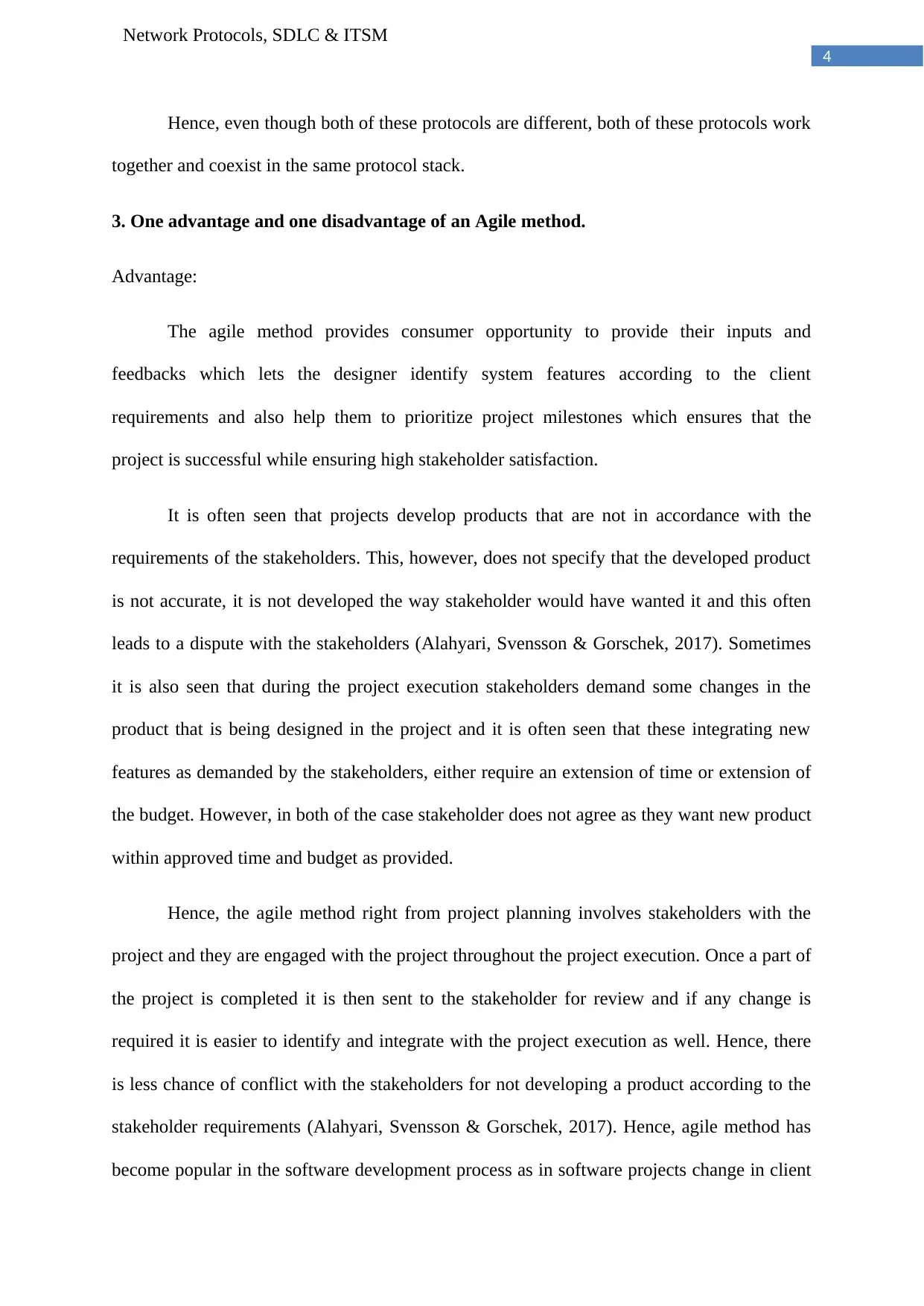
4
Network Protocols, SDLC & ITSM
Hence, even though both of these protocols are different, both of these protocols work
together and coexist in the same protocol stack.
3. One advantage and one disadvantage of an Agile method.
Advantage:
The agile method provides consumer opportunity to provide their inputs and
feedbacks which lets the designer identify system features according to the client
requirements and also help them to prioritize project milestones which ensures that the
project is successful while ensuring high stakeholder satisfaction.
It is often seen that projects develop products that are not in accordance with the
requirements of the stakeholders. This, however, does not specify that the developed product
is not accurate, it is not developed the way stakeholder would have wanted it and this often
leads to a dispute with the stakeholders (Alahyari, Svensson & Gorschek, 2017). Sometimes
it is also seen that during the project execution stakeholders demand some changes in the
product that is being designed in the project and it is often seen that these integrating new
features as demanded by the stakeholders, either require an extension of time or extension of
the budget. However, in both of the case stakeholder does not agree as they want new product
within approved time and budget as provided.
Hence, the agile method right from project planning involves stakeholders with the
project and they are engaged with the project throughout the project execution. Once a part of
the project is completed it is then sent to the stakeholder for review and if any change is
required it is easier to identify and integrate with the project execution as well. Hence, there
is less chance of conflict with the stakeholders for not developing a product according to the
stakeholder requirements (Alahyari, Svensson & Gorschek, 2017). Hence, agile method has
become popular in the software development process as in software projects change in client
Network Protocols, SDLC & ITSM
Hence, even though both of these protocols are different, both of these protocols work
together and coexist in the same protocol stack.
3. One advantage and one disadvantage of an Agile method.
Advantage:
The agile method provides consumer opportunity to provide their inputs and
feedbacks which lets the designer identify system features according to the client
requirements and also help them to prioritize project milestones which ensures that the
project is successful while ensuring high stakeholder satisfaction.
It is often seen that projects develop products that are not in accordance with the
requirements of the stakeholders. This, however, does not specify that the developed product
is not accurate, it is not developed the way stakeholder would have wanted it and this often
leads to a dispute with the stakeholders (Alahyari, Svensson & Gorschek, 2017). Sometimes
it is also seen that during the project execution stakeholders demand some changes in the
product that is being designed in the project and it is often seen that these integrating new
features as demanded by the stakeholders, either require an extension of time or extension of
the budget. However, in both of the case stakeholder does not agree as they want new product
within approved time and budget as provided.
Hence, the agile method right from project planning involves stakeholders with the
project and they are engaged with the project throughout the project execution. Once a part of
the project is completed it is then sent to the stakeholder for review and if any change is
required it is easier to identify and integrate with the project execution as well. Hence, there
is less chance of conflict with the stakeholders for not developing a product according to the
stakeholder requirements (Alahyari, Svensson & Gorschek, 2017). Hence, agile method has
become popular in the software development process as in software projects change in client
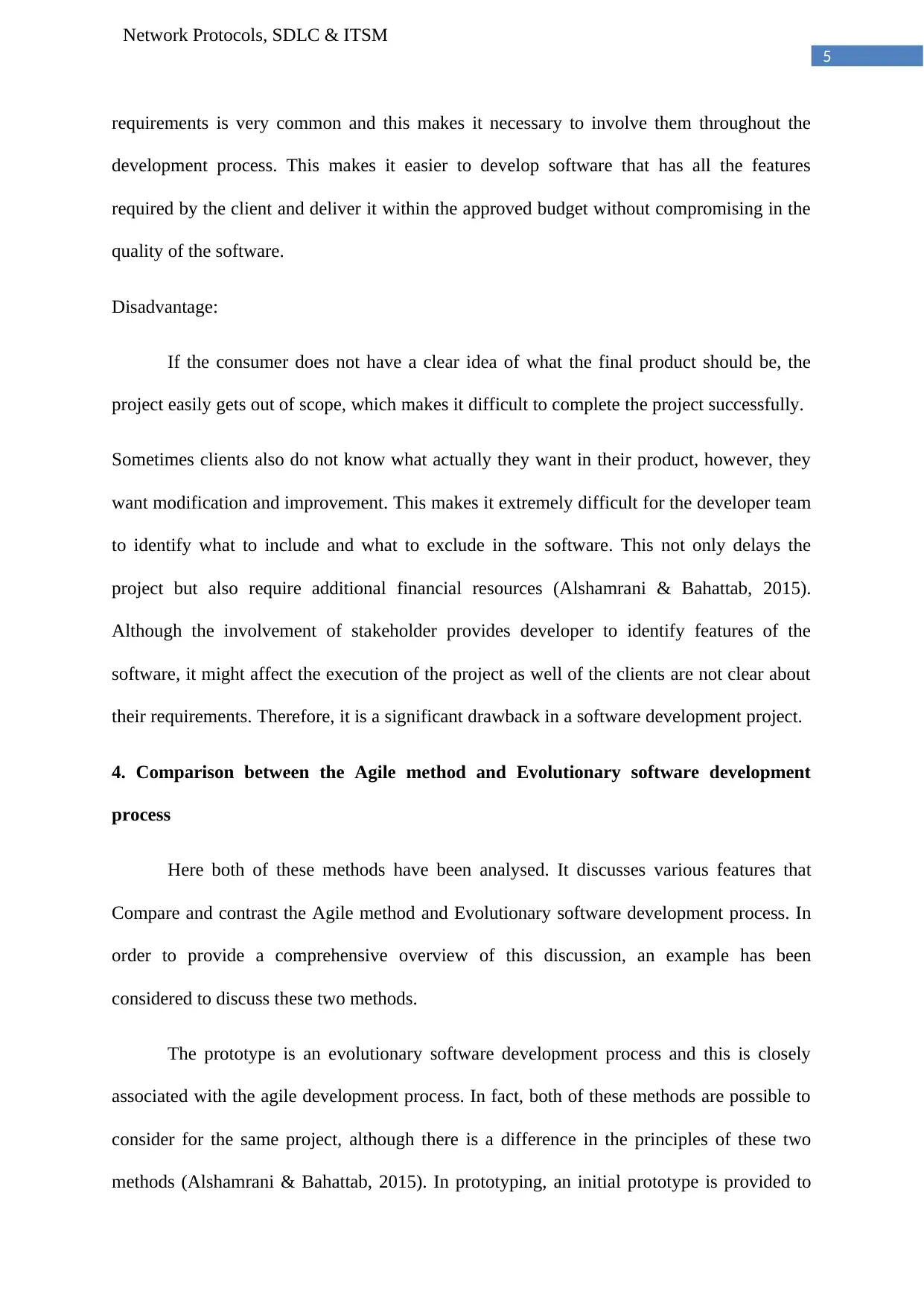
5
Network Protocols, SDLC & ITSM
requirements is very common and this makes it necessary to involve them throughout the
development process. This makes it easier to develop software that has all the features
required by the client and deliver it within the approved budget without compromising in the
quality of the software.
Disadvantage:
If the consumer does not have a clear idea of what the final product should be, the
project easily gets out of scope, which makes it difficult to complete the project successfully.
Sometimes clients also do not know what actually they want in their product, however, they
want modification and improvement. This makes it extremely difficult for the developer team
to identify what to include and what to exclude in the software. This not only delays the
project but also require additional financial resources (Alshamrani & Bahattab, 2015).
Although the involvement of stakeholder provides developer to identify features of the
software, it might affect the execution of the project as well of the clients are not clear about
their requirements. Therefore, it is a significant drawback in a software development project.
4. Comparison between the Agile method and Evolutionary software development
process
Here both of these methods have been analysed. It discusses various features that
Compare and contrast the Agile method and Evolutionary software development process. In
order to provide a comprehensive overview of this discussion, an example has been
considered to discuss these two methods.
The prototype is an evolutionary software development process and this is closely
associated with the agile development process. In fact, both of these methods are possible to
consider for the same project, although there is a difference in the principles of these two
methods (Alshamrani & Bahattab, 2015). In prototyping, an initial prototype is provided to
Network Protocols, SDLC & ITSM
requirements is very common and this makes it necessary to involve them throughout the
development process. This makes it easier to develop software that has all the features
required by the client and deliver it within the approved budget without compromising in the
quality of the software.
Disadvantage:
If the consumer does not have a clear idea of what the final product should be, the
project easily gets out of scope, which makes it difficult to complete the project successfully.
Sometimes clients also do not know what actually they want in their product, however, they
want modification and improvement. This makes it extremely difficult for the developer team
to identify what to include and what to exclude in the software. This not only delays the
project but also require additional financial resources (Alshamrani & Bahattab, 2015).
Although the involvement of stakeholder provides developer to identify features of the
software, it might affect the execution of the project as well of the clients are not clear about
their requirements. Therefore, it is a significant drawback in a software development project.
4. Comparison between the Agile method and Evolutionary software development
process
Here both of these methods have been analysed. It discusses various features that
Compare and contrast the Agile method and Evolutionary software development process. In
order to provide a comprehensive overview of this discussion, an example has been
considered to discuss these two methods.
The prototype is an evolutionary software development process and this is closely
associated with the agile development process. In fact, both of these methods are possible to
consider for the same project, although there is a difference in the principles of these two
methods (Alshamrani & Bahattab, 2015). In prototyping, an initial prototype is provided to
⊘ This is a preview!⊘
Do you want full access?
Subscribe today to unlock all pages.

Trusted by 1+ million students worldwide
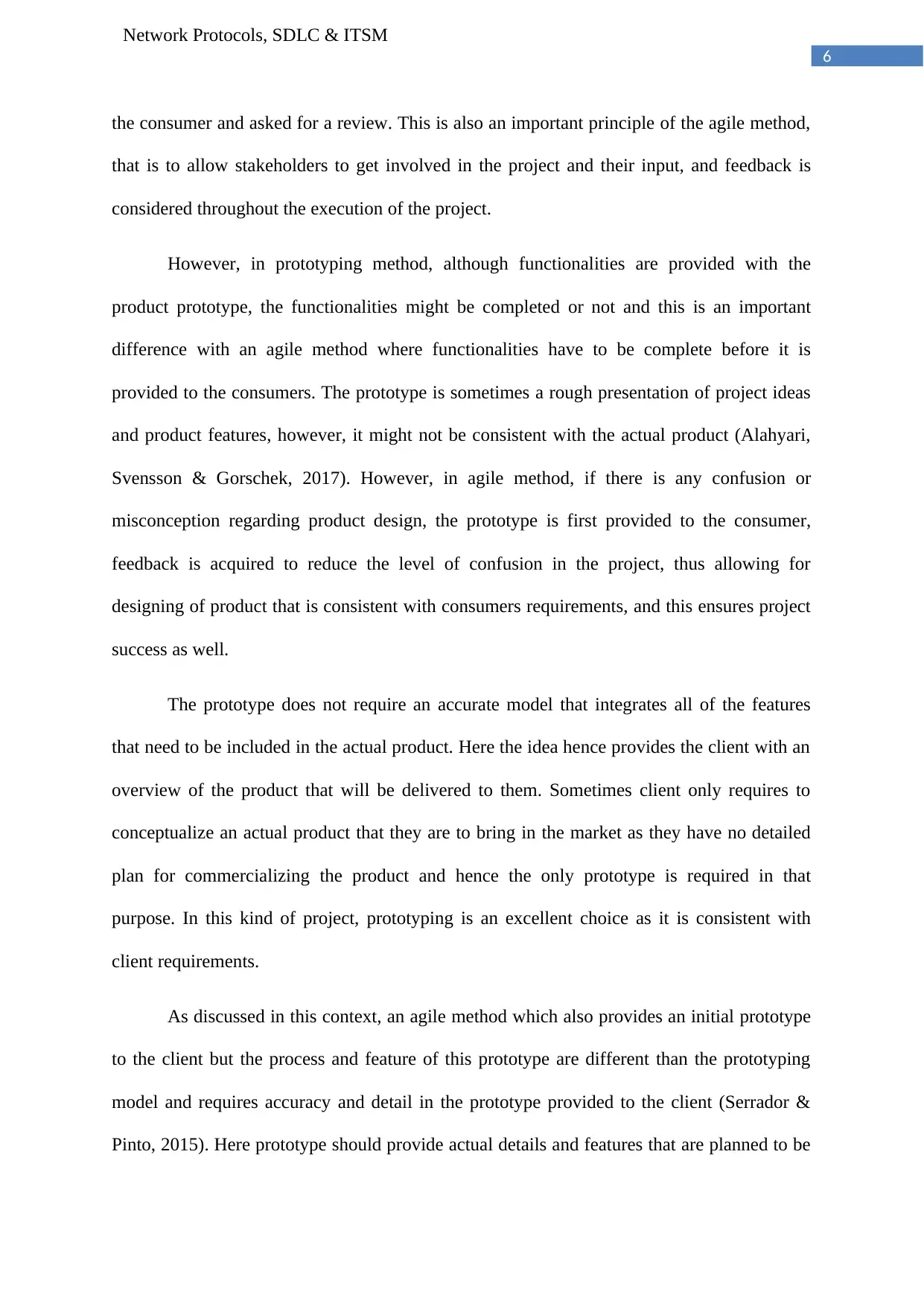
6
Network Protocols, SDLC & ITSM
the consumer and asked for a review. This is also an important principle of the agile method,
that is to allow stakeholders to get involved in the project and their input, and feedback is
considered throughout the execution of the project.
However, in prototyping method, although functionalities are provided with the
product prototype, the functionalities might be completed or not and this is an important
difference with an agile method where functionalities have to be complete before it is
provided to the consumers. The prototype is sometimes a rough presentation of project ideas
and product features, however, it might not be consistent with the actual product (Alahyari,
Svensson & Gorschek, 2017). However, in agile method, if there is any confusion or
misconception regarding product design, the prototype is first provided to the consumer,
feedback is acquired to reduce the level of confusion in the project, thus allowing for
designing of product that is consistent with consumers requirements, and this ensures project
success as well.
The prototype does not require an accurate model that integrates all of the features
that need to be included in the actual product. Here the idea hence provides the client with an
overview of the product that will be delivered to them. Sometimes client only requires to
conceptualize an actual product that they are to bring in the market as they have no detailed
plan for commercializing the product and hence the only prototype is required in that
purpose. In this kind of project, prototyping is an excellent choice as it is consistent with
client requirements.
As discussed in this context, an agile method which also provides an initial prototype
to the client but the process and feature of this prototype are different than the prototyping
model and requires accuracy and detail in the prototype provided to the client (Serrador &
Pinto, 2015). Here prototype should provide actual details and features that are planned to be
Network Protocols, SDLC & ITSM
the consumer and asked for a review. This is also an important principle of the agile method,
that is to allow stakeholders to get involved in the project and their input, and feedback is
considered throughout the execution of the project.
However, in prototyping method, although functionalities are provided with the
product prototype, the functionalities might be completed or not and this is an important
difference with an agile method where functionalities have to be complete before it is
provided to the consumers. The prototype is sometimes a rough presentation of project ideas
and product features, however, it might not be consistent with the actual product (Alahyari,
Svensson & Gorschek, 2017). However, in agile method, if there is any confusion or
misconception regarding product design, the prototype is first provided to the consumer,
feedback is acquired to reduce the level of confusion in the project, thus allowing for
designing of product that is consistent with consumers requirements, and this ensures project
success as well.
The prototype does not require an accurate model that integrates all of the features
that need to be included in the actual product. Here the idea hence provides the client with an
overview of the product that will be delivered to them. Sometimes client only requires to
conceptualize an actual product that they are to bring in the market as they have no detailed
plan for commercializing the product and hence the only prototype is required in that
purpose. In this kind of project, prototyping is an excellent choice as it is consistent with
client requirements.
As discussed in this context, an agile method which also provides an initial prototype
to the client but the process and feature of this prototype are different than the prototyping
model and requires accuracy and detail in the prototype provided to the client (Serrador &
Pinto, 2015). Here prototype should provide actual details and features that are planned to be
Paraphrase This Document
Need a fresh take? Get an instant paraphrase of this document with our AI Paraphraser
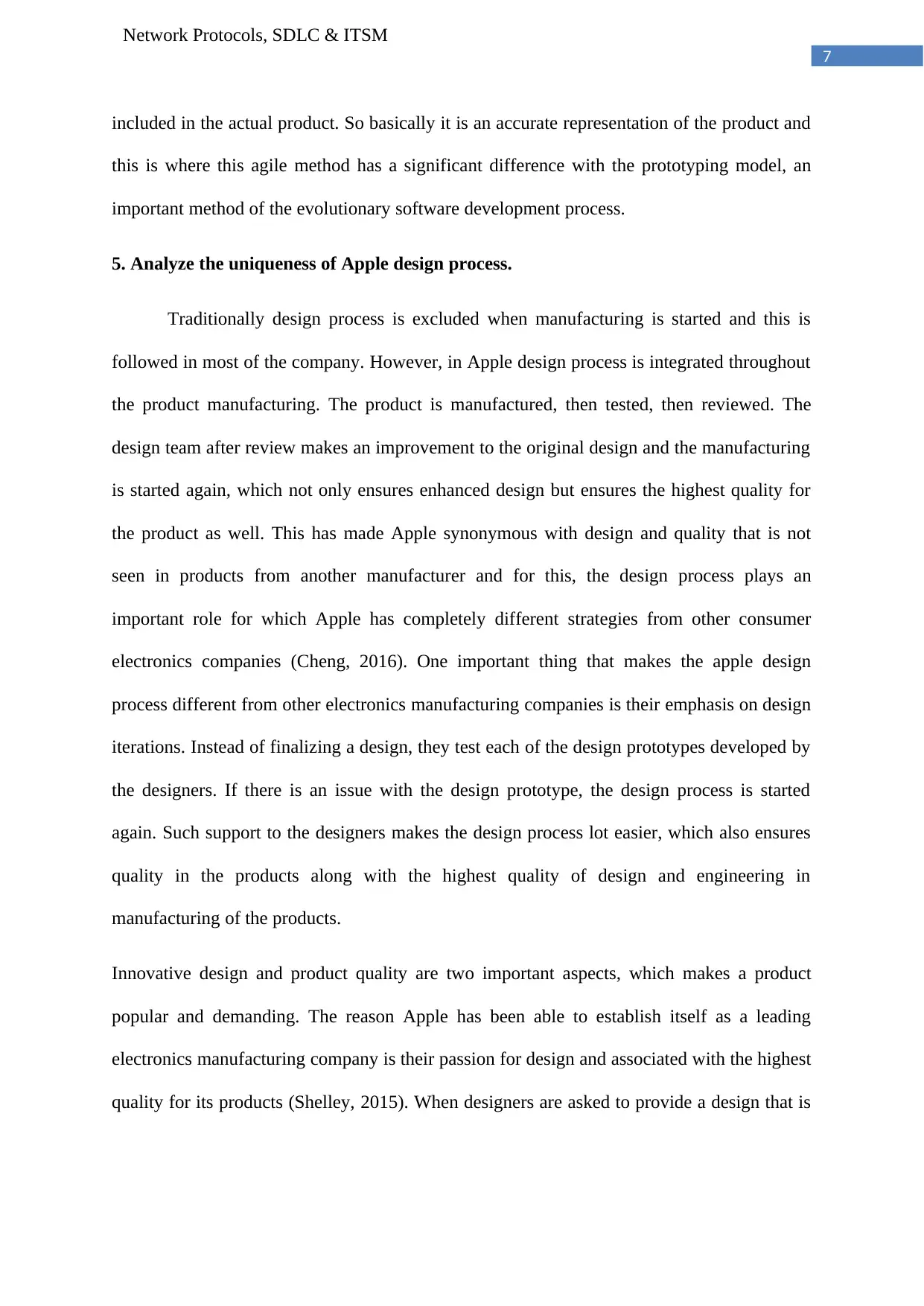
7
Network Protocols, SDLC & ITSM
included in the actual product. So basically it is an accurate representation of the product and
this is where this agile method has a significant difference with the prototyping model, an
important method of the evolutionary software development process.
5. Analyze the uniqueness of Apple design process.
Traditionally design process is excluded when manufacturing is started and this is
followed in most of the company. However, in Apple design process is integrated throughout
the product manufacturing. The product is manufactured, then tested, then reviewed. The
design team after review makes an improvement to the original design and the manufacturing
is started again, which not only ensures enhanced design but ensures the highest quality for
the product as well. This has made Apple synonymous with design and quality that is not
seen in products from another manufacturer and for this, the design process plays an
important role for which Apple has completely different strategies from other consumer
electronics companies (Cheng, 2016). One important thing that makes the apple design
process different from other electronics manufacturing companies is their emphasis on design
iterations. Instead of finalizing a design, they test each of the design prototypes developed by
the designers. If there is an issue with the design prototype, the design process is started
again. Such support to the designers makes the design process lot easier, which also ensures
quality in the products along with the highest quality of design and engineering in
manufacturing of the products.
Innovative design and product quality are two important aspects, which makes a product
popular and demanding. The reason Apple has been able to establish itself as a leading
electronics manufacturing company is their passion for design and associated with the highest
quality for its products (Shelley, 2015). When designers are asked to provide a design that is
Network Protocols, SDLC & ITSM
included in the actual product. So basically it is an accurate representation of the product and
this is where this agile method has a significant difference with the prototyping model, an
important method of the evolutionary software development process.
5. Analyze the uniqueness of Apple design process.
Traditionally design process is excluded when manufacturing is started and this is
followed in most of the company. However, in Apple design process is integrated throughout
the product manufacturing. The product is manufactured, then tested, then reviewed. The
design team after review makes an improvement to the original design and the manufacturing
is started again, which not only ensures enhanced design but ensures the highest quality for
the product as well. This has made Apple synonymous with design and quality that is not
seen in products from another manufacturer and for this, the design process plays an
important role for which Apple has completely different strategies from other consumer
electronics companies (Cheng, 2016). One important thing that makes the apple design
process different from other electronics manufacturing companies is their emphasis on design
iterations. Instead of finalizing a design, they test each of the design prototypes developed by
the designers. If there is an issue with the design prototype, the design process is started
again. Such support to the designers makes the design process lot easier, which also ensures
quality in the products along with the highest quality of design and engineering in
manufacturing of the products.
Innovative design and product quality are two important aspects, which makes a product
popular and demanding. The reason Apple has been able to establish itself as a leading
electronics manufacturing company is their passion for design and associated with the highest
quality for its products (Shelley, 2015). When designers are asked to provide a design that is
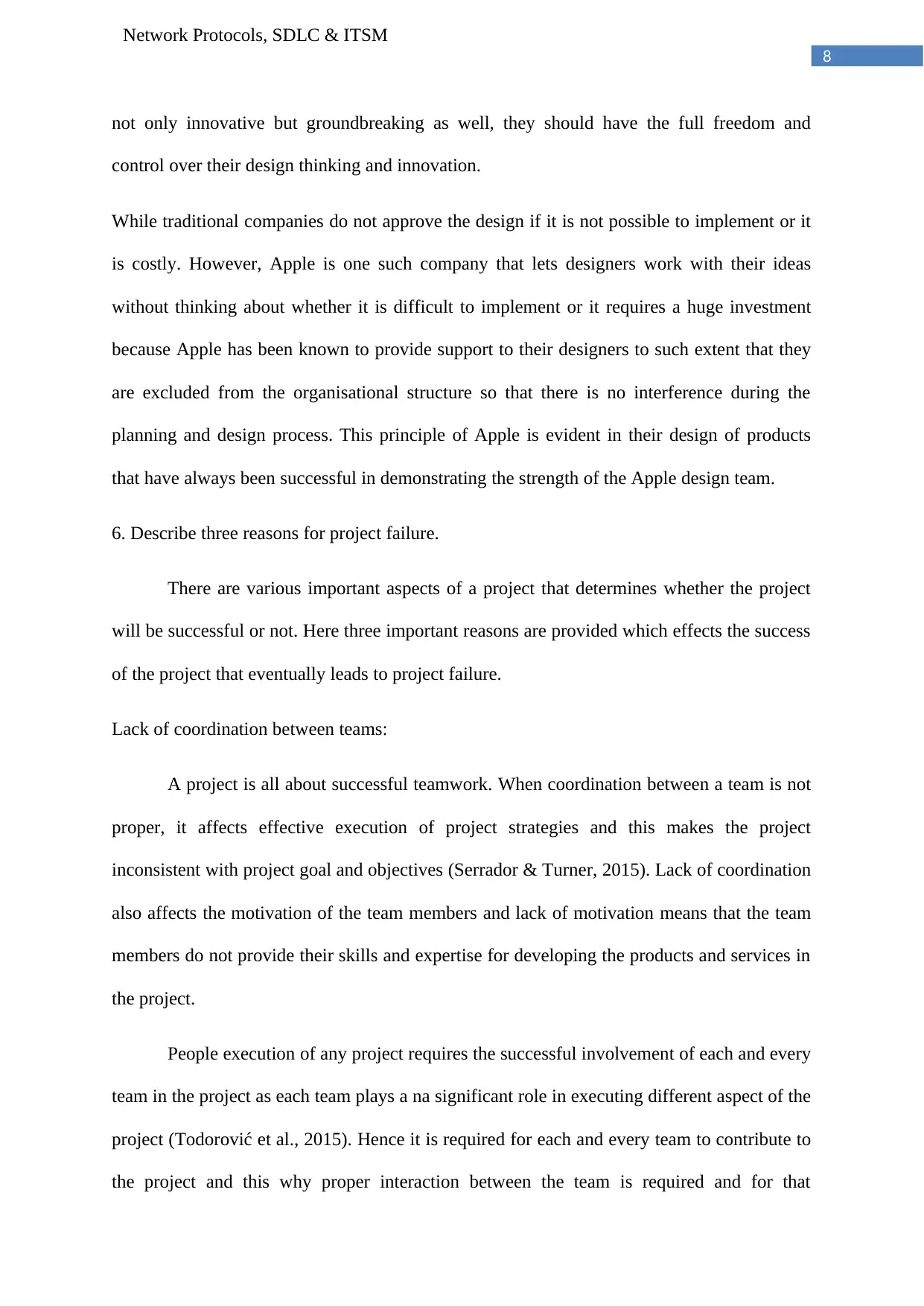
8
Network Protocols, SDLC & ITSM
not only innovative but groundbreaking as well, they should have the full freedom and
control over their design thinking and innovation.
While traditional companies do not approve the design if it is not possible to implement or it
is costly. However, Apple is one such company that lets designers work with their ideas
without thinking about whether it is difficult to implement or it requires a huge investment
because Apple has been known to provide support to their designers to such extent that they
are excluded from the organisational structure so that there is no interference during the
planning and design process. This principle of Apple is evident in their design of products
that have always been successful in demonstrating the strength of the Apple design team.
6. Describe three reasons for project failure.
There are various important aspects of a project that determines whether the project
will be successful or not. Here three important reasons are provided which effects the success
of the project that eventually leads to project failure.
Lack of coordination between teams:
A project is all about successful teamwork. When coordination between a team is not
proper, it affects effective execution of project strategies and this makes the project
inconsistent with project goal and objectives (Serrador & Turner, 2015). Lack of coordination
also affects the motivation of the team members and lack of motivation means that the team
members do not provide their skills and expertise for developing the products and services in
the project.
People execution of any project requires the successful involvement of each and every
team in the project as each team plays a na significant role in executing different aspect of the
project (Todorović et al., 2015). Hence it is required for each and every team to contribute to
the project and this why proper interaction between the team is required and for that
Network Protocols, SDLC & ITSM
not only innovative but groundbreaking as well, they should have the full freedom and
control over their design thinking and innovation.
While traditional companies do not approve the design if it is not possible to implement or it
is costly. However, Apple is one such company that lets designers work with their ideas
without thinking about whether it is difficult to implement or it requires a huge investment
because Apple has been known to provide support to their designers to such extent that they
are excluded from the organisational structure so that there is no interference during the
planning and design process. This principle of Apple is evident in their design of products
that have always been successful in demonstrating the strength of the Apple design team.
6. Describe three reasons for project failure.
There are various important aspects of a project that determines whether the project
will be successful or not. Here three important reasons are provided which effects the success
of the project that eventually leads to project failure.
Lack of coordination between teams:
A project is all about successful teamwork. When coordination between a team is not
proper, it affects effective execution of project strategies and this makes the project
inconsistent with project goal and objectives (Serrador & Turner, 2015). Lack of coordination
also affects the motivation of the team members and lack of motivation means that the team
members do not provide their skills and expertise for developing the products and services in
the project.
People execution of any project requires the successful involvement of each and every
team in the project as each team plays a na significant role in executing different aspect of the
project (Todorović et al., 2015). Hence it is required for each and every team to contribute to
the project and this why proper interaction between the team is required and for that
⊘ This is a preview!⊘
Do you want full access?
Subscribe today to unlock all pages.

Trusted by 1+ million students worldwide
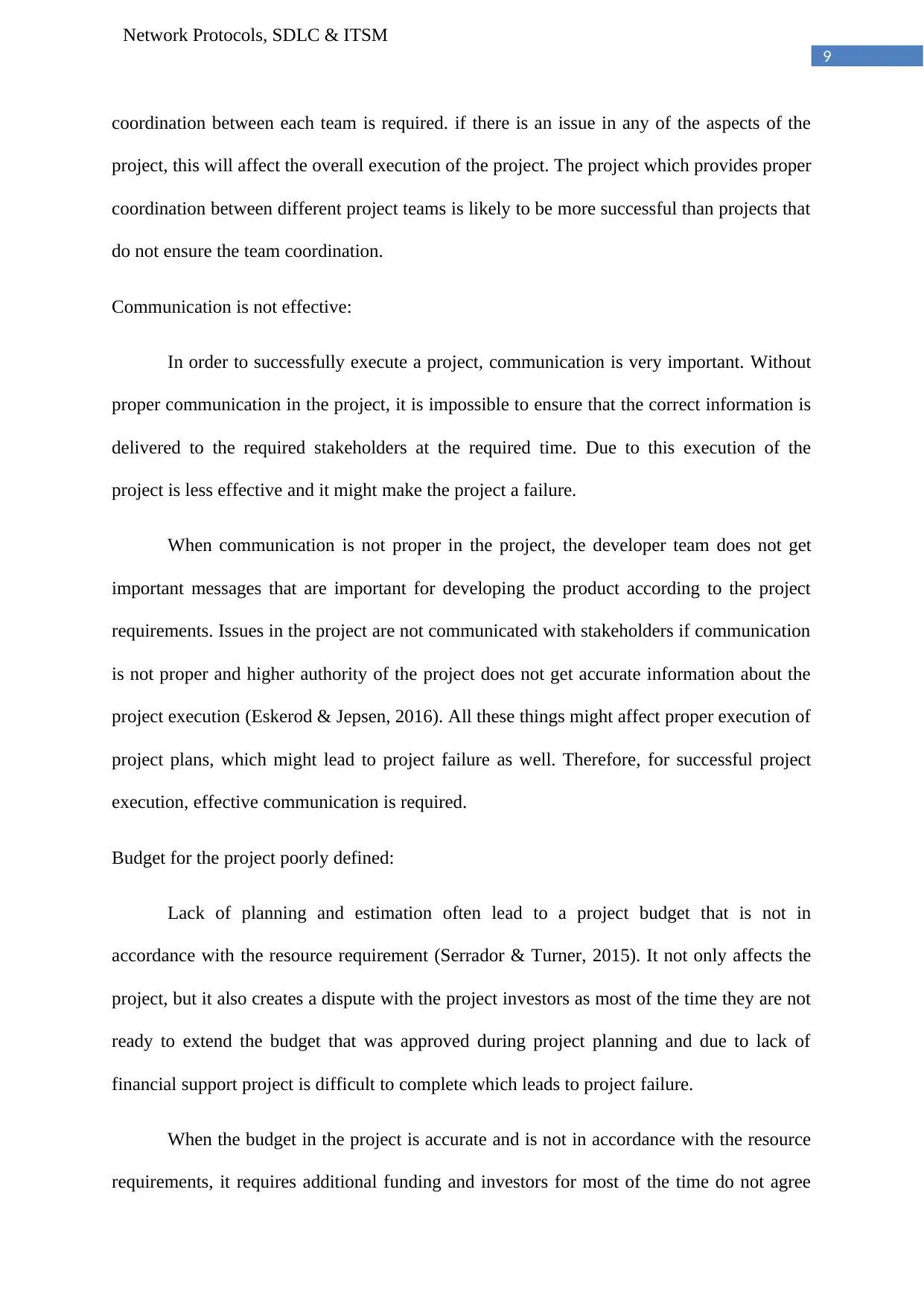
9
Network Protocols, SDLC & ITSM
coordination between each team is required. if there is an issue in any of the aspects of the
project, this will affect the overall execution of the project. The project which provides proper
coordination between different project teams is likely to be more successful than projects that
do not ensure the team coordination.
Communication is not effective:
In order to successfully execute a project, communication is very important. Without
proper communication in the project, it is impossible to ensure that the correct information is
delivered to the required stakeholders at the required time. Due to this execution of the
project is less effective and it might make the project a failure.
When communication is not proper in the project, the developer team does not get
important messages that are important for developing the product according to the project
requirements. Issues in the project are not communicated with stakeholders if communication
is not proper and higher authority of the project does not get accurate information about the
project execution (Eskerod & Jepsen, 2016). All these things might affect proper execution of
project plans, which might lead to project failure as well. Therefore, for successful project
execution, effective communication is required.
Budget for the project poorly defined:
Lack of planning and estimation often lead to a project budget that is not in
accordance with the resource requirement (Serrador & Turner, 2015). It not only affects the
project, but it also creates a dispute with the project investors as most of the time they are not
ready to extend the budget that was approved during project planning and due to lack of
financial support project is difficult to complete which leads to project failure.
When the budget in the project is accurate and is not in accordance with the resource
requirements, it requires additional funding and investors for most of the time do not agree
Network Protocols, SDLC & ITSM
coordination between each team is required. if there is an issue in any of the aspects of the
project, this will affect the overall execution of the project. The project which provides proper
coordination between different project teams is likely to be more successful than projects that
do not ensure the team coordination.
Communication is not effective:
In order to successfully execute a project, communication is very important. Without
proper communication in the project, it is impossible to ensure that the correct information is
delivered to the required stakeholders at the required time. Due to this execution of the
project is less effective and it might make the project a failure.
When communication is not proper in the project, the developer team does not get
important messages that are important for developing the product according to the project
requirements. Issues in the project are not communicated with stakeholders if communication
is not proper and higher authority of the project does not get accurate information about the
project execution (Eskerod & Jepsen, 2016). All these things might affect proper execution of
project plans, which might lead to project failure as well. Therefore, for successful project
execution, effective communication is required.
Budget for the project poorly defined:
Lack of planning and estimation often lead to a project budget that is not in
accordance with the resource requirement (Serrador & Turner, 2015). It not only affects the
project, but it also creates a dispute with the project investors as most of the time they are not
ready to extend the budget that was approved during project planning and due to lack of
financial support project is difficult to complete which leads to project failure.
When the budget in the project is accurate and is not in accordance with the resource
requirements, it requires additional funding and investors for most of the time do not agree
Paraphrase This Document
Need a fresh take? Get an instant paraphrase of this document with our AI Paraphraser
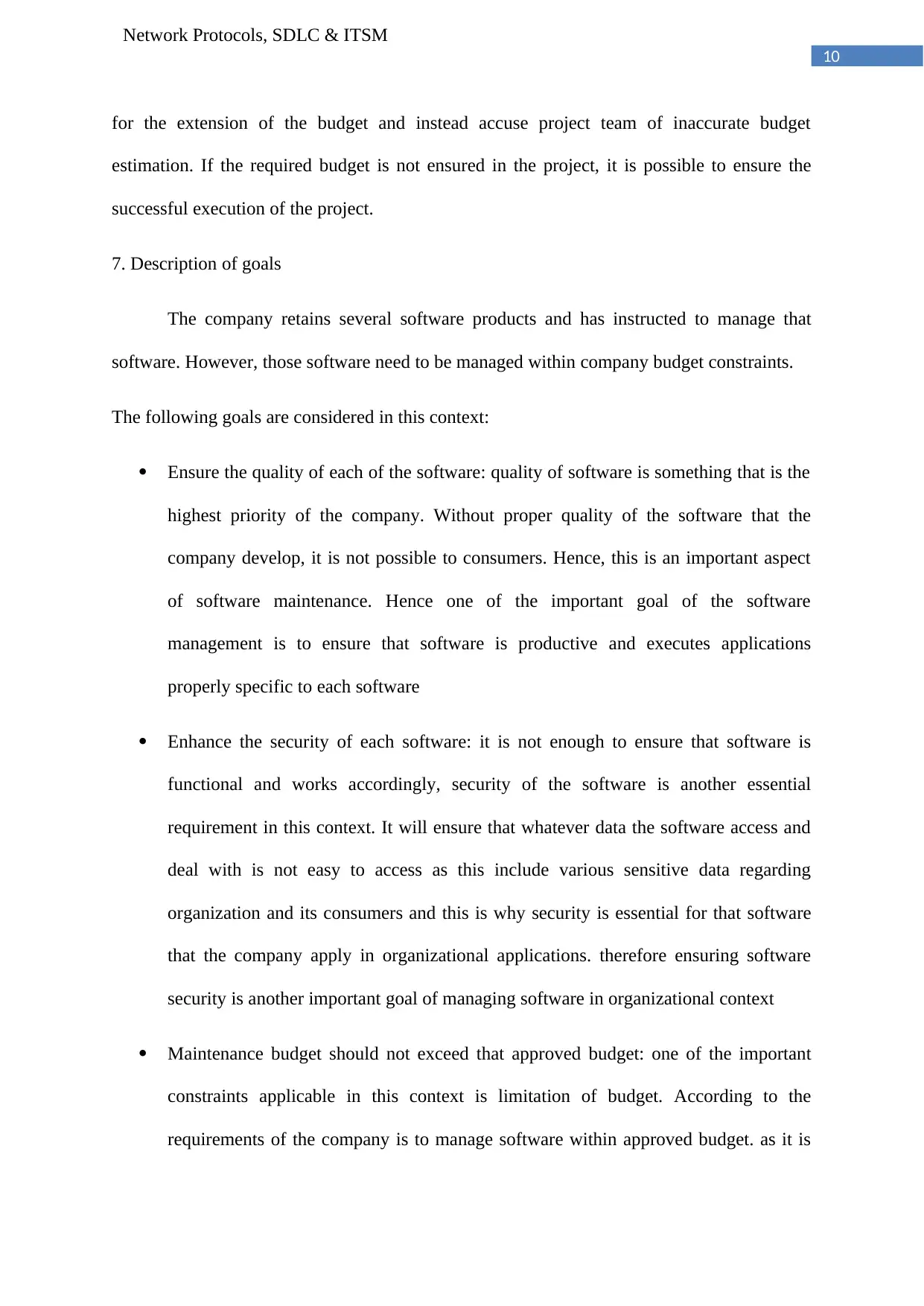
10
Network Protocols, SDLC & ITSM
for the extension of the budget and instead accuse project team of inaccurate budget
estimation. If the required budget is not ensured in the project, it is possible to ensure the
successful execution of the project.
7. Description of goals
The company retains several software products and has instructed to manage that
software. However, those software need to be managed within company budget constraints.
The following goals are considered in this context:
Ensure the quality of each of the software: quality of software is something that is the
highest priority of the company. Without proper quality of the software that the
company develop, it is not possible to consumers. Hence, this is an important aspect
of software maintenance. Hence one of the important goal of the software
management is to ensure that software is productive and executes applications
properly specific to each software
Enhance the security of each software: it is not enough to ensure that software is
functional and works accordingly, security of the software is another essential
requirement in this context. It will ensure that whatever data the software access and
deal with is not easy to access as this include various sensitive data regarding
organization and its consumers and this is why security is essential for that software
that the company apply in organizational applications. therefore ensuring software
security is another important goal of managing software in organizational context
Maintenance budget should not exceed that approved budget: one of the important
constraints applicable in this context is limitation of budget. According to the
requirements of the company is to manage software within approved budget. as it is
Network Protocols, SDLC & ITSM
for the extension of the budget and instead accuse project team of inaccurate budget
estimation. If the required budget is not ensured in the project, it is possible to ensure the
successful execution of the project.
7. Description of goals
The company retains several software products and has instructed to manage that
software. However, those software need to be managed within company budget constraints.
The following goals are considered in this context:
Ensure the quality of each of the software: quality of software is something that is the
highest priority of the company. Without proper quality of the software that the
company develop, it is not possible to consumers. Hence, this is an important aspect
of software maintenance. Hence one of the important goal of the software
management is to ensure that software is productive and executes applications
properly specific to each software
Enhance the security of each software: it is not enough to ensure that software is
functional and works accordingly, security of the software is another essential
requirement in this context. It will ensure that whatever data the software access and
deal with is not easy to access as this include various sensitive data regarding
organization and its consumers and this is why security is essential for that software
that the company apply in organizational applications. therefore ensuring software
security is another important goal of managing software in organizational context
Maintenance budget should not exceed that approved budget: one of the important
constraints applicable in this context is limitation of budget. According to the
requirements of the company is to manage software within approved budget. as it is
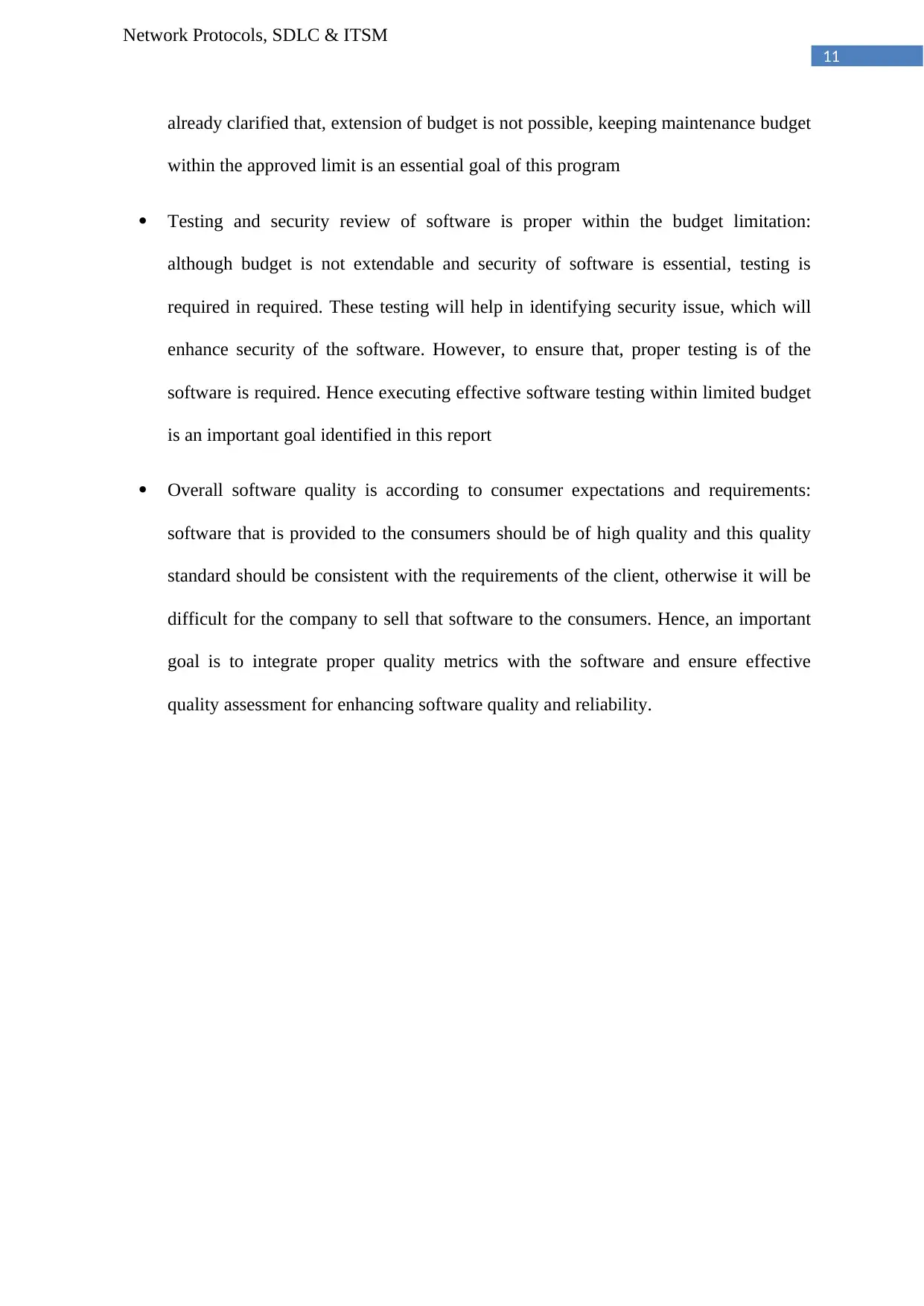
11
Network Protocols, SDLC & ITSM
already clarified that, extension of budget is not possible, keeping maintenance budget
within the approved limit is an essential goal of this program
Testing and security review of software is proper within the budget limitation:
although budget is not extendable and security of software is essential, testing is
required in required. These testing will help in identifying security issue, which will
enhance security of the software. However, to ensure that, proper testing is of the
software is required. Hence executing effective software testing within limited budget
is an important goal identified in this report
Overall software quality is according to consumer expectations and requirements:
software that is provided to the consumers should be of high quality and this quality
standard should be consistent with the requirements of the client, otherwise it will be
difficult for the company to sell that software to the consumers. Hence, an important
goal is to integrate proper quality metrics with the software and ensure effective
quality assessment for enhancing software quality and reliability.
Network Protocols, SDLC & ITSM
already clarified that, extension of budget is not possible, keeping maintenance budget
within the approved limit is an essential goal of this program
Testing and security review of software is proper within the budget limitation:
although budget is not extendable and security of software is essential, testing is
required in required. These testing will help in identifying security issue, which will
enhance security of the software. However, to ensure that, proper testing is of the
software is required. Hence executing effective software testing within limited budget
is an important goal identified in this report
Overall software quality is according to consumer expectations and requirements:
software that is provided to the consumers should be of high quality and this quality
standard should be consistent with the requirements of the client, otherwise it will be
difficult for the company to sell that software to the consumers. Hence, an important
goal is to integrate proper quality metrics with the software and ensure effective
quality assessment for enhancing software quality and reliability.
⊘ This is a preview!⊘
Do you want full access?
Subscribe today to unlock all pages.

Trusted by 1+ million students worldwide
1 out of 14
Related Documents
Your All-in-One AI-Powered Toolkit for Academic Success.
+13062052269
info@desklib.com
Available 24*7 on WhatsApp / Email
![[object Object]](/_next/static/media/star-bottom.7253800d.svg)
Unlock your academic potential
Copyright © 2020–2025 A2Z Services. All Rights Reserved. Developed and managed by ZUCOL.

